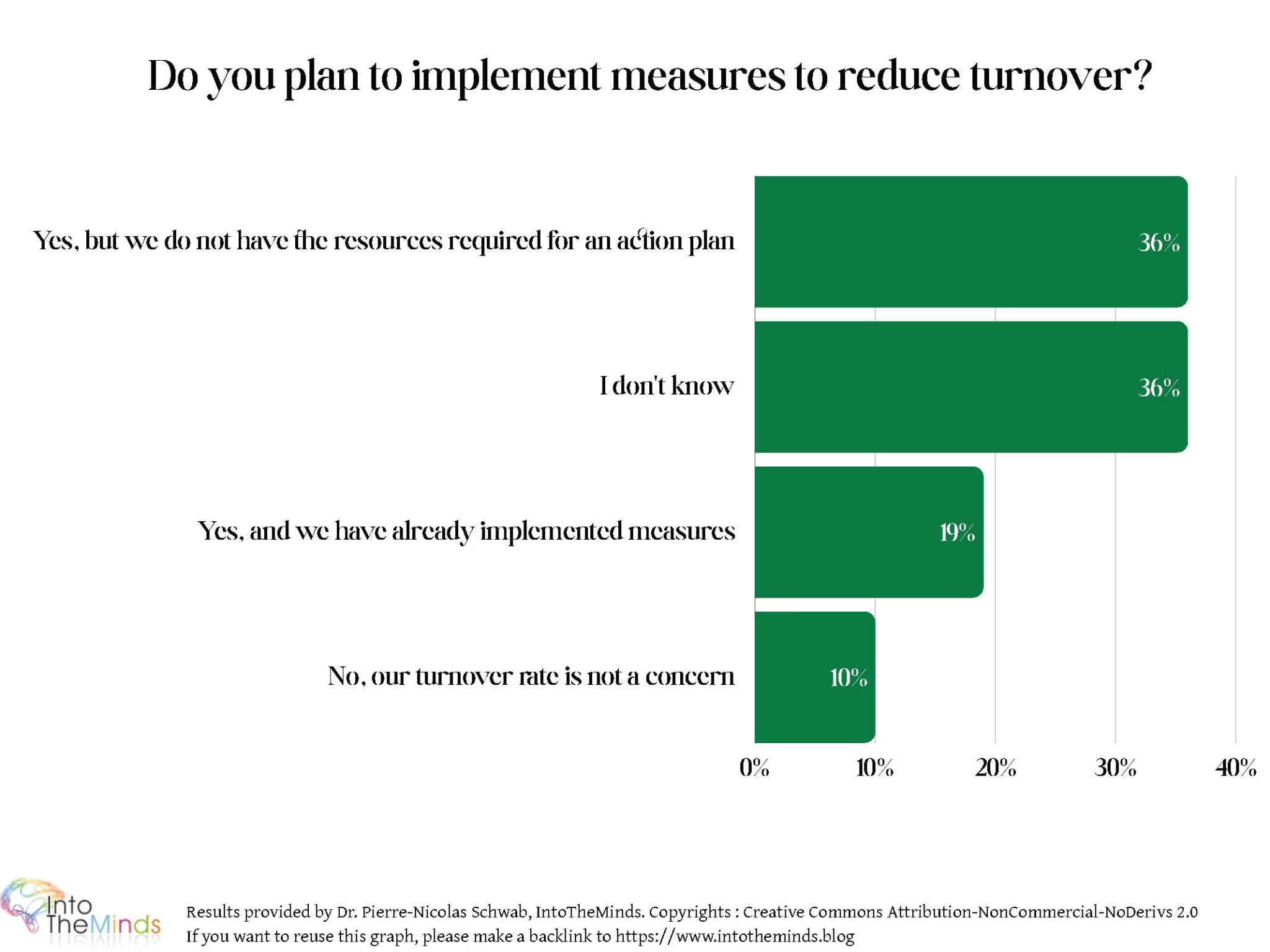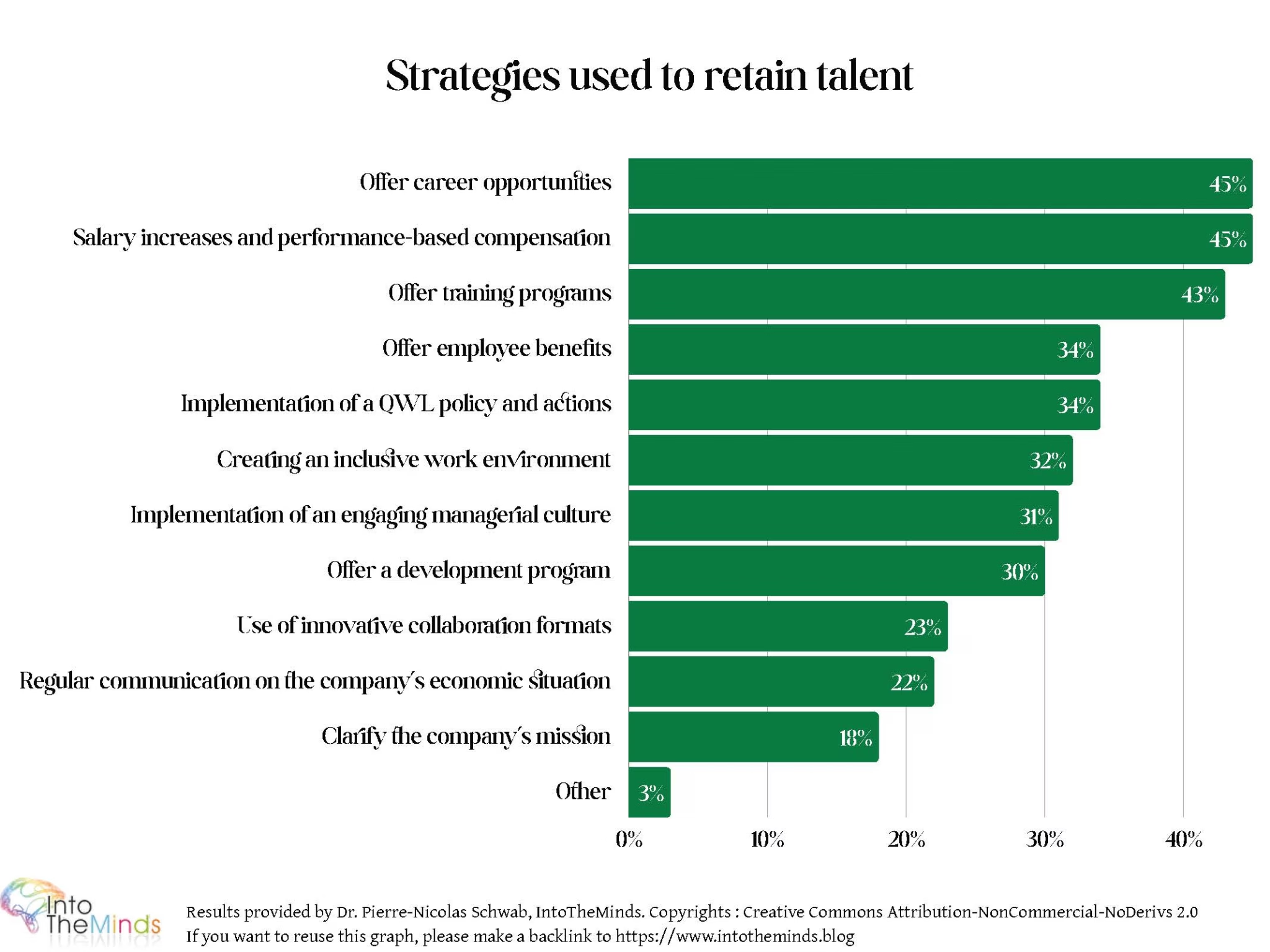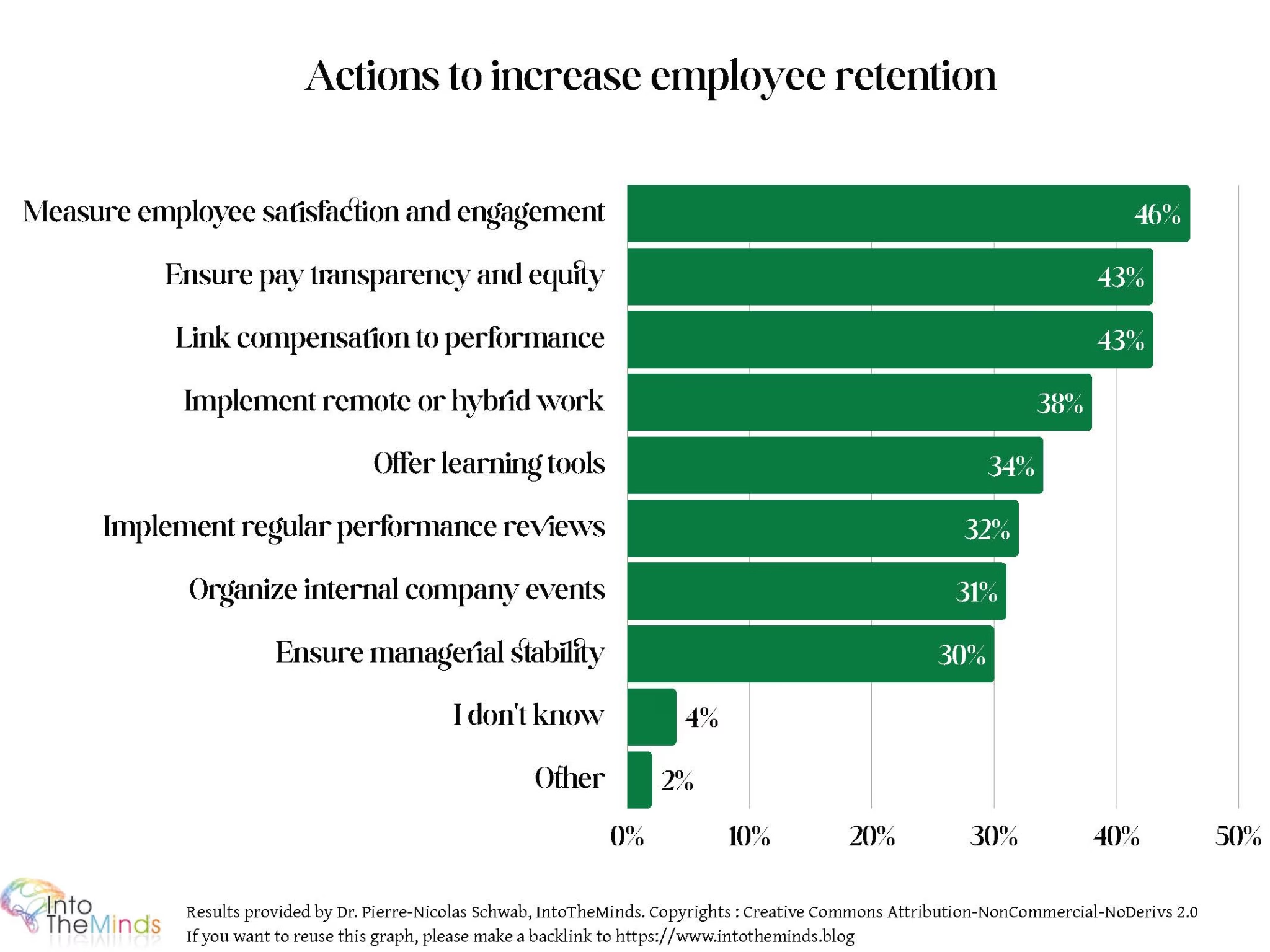How can turnover be reduced? This question does not seem to obsess all companies in the same way. We surveyed 1,000 HR managers across 5 countries and revealed their current and future strategies.
![Turnover: what strategies are companies implementing? [Study]](https://5cc2b83c.delivery.rocketcdn.me/app/uploads/banner-millenial-employee.jpg)
One of the biggest challenges for companies is talent retention, that is, reducing turnover. Ensuring employee loyalty is a key success factor, as it allows companies to plan confidently for the future without fearing the sudden departure of their best talent.
The 2025 HR study we conducted with 1000 HR managers in 5 countries (via an online survey in France, Spain, Italy, Germany, and the UK) provides a precise overview of the turnover situation as well as concrete actions implemented to retain employees.
Contact IntoTheMinds for your HR studies
Main study figures
- 36% of companies do not know their staff turnover rate
- 36% of companies lack the resources to implement necessary actions to retain employees
- Career opportunities and salary increases are the two most used strategies to retain employees (45% of surveyed companies rely on them)
- 38% of companies with fewer than 49 employees, and 50% of companies with more than 500 employees, offer career plans
- Social benefits are offered by 37% of companies with more than 500 employees, but only 29% of those with fewer than 49 employees
- The retention strategies HR managers would like to implement in the future focus on three proposals:
- measuring satisfaction and engagement (46%)
- ensuring transparency and pay equity (43%)
- linking pay to performance (43%)
Overall, the most commonly used strategies to retain employees center around highly practical actions. Companies primarily offer:
- career opportunities, meaning the ability for employees to grow within the company
- a salary increase or performance bonus
- training programs
These results align with other studies showing that skill development and competitive pay are essential levers to reduce turnover. Our study results also highlight that other levers are activated, such as inclusive policies and a supportive management culture.
Turnover: a strategic issue?
The first question to ask is whether companies perceive turnover as an issue. To this end, we asked a question that allowed us to assess both the actions taken and the company’s level of knowledge about turnover. Let’s start with this figure: 36% of companies do not know their staff turnover rate. This could be due to a lack of understanding of the term “turnover” itself, but we took care to explain it before asking the question. I therefore believe this reflects an absence of tracking this indicator. Companies do not see enough value in calculating it, which likely reveals a lack of awareness of the risk it poses.
Equally surprising is the percentage of companies aware of the issue but taking no action. 36% of companies report indeed considering actions but lacking the necessary resources. In other words, they are patiently waiting for the risk of a departure to materialize. This is extremely dangerous because the realization of the risk is particularly devastating, especially for SMEs. The departure of one or two employees can often disrupt the entire company’s operations.
Only a minority of companies report having no turnover issues. This does exist but is rare. In a recent qualitative study, we conducted semi-structured interviews with HR managers and identified a few companies in this category. These were always fast-growing tech startups that attracted highly specialized profiles.
Analysis by company size provides additional insight. As you can see in the table below, the situation varies significantly depending on company size. I think it’s quite interesting to compare the first two rows of the table. You will clearly see the effect of company size.
Companies that have implemented actions to retain talent
We note a positive effect of company size on the implementation of retention actions. In other words, the larger the company, the higher the likelihood that actions have been put in place. This is logical since, as we will see later in this article, certain actions are the preserve of larger companies. For example, it’s difficult to offer a career plan in a two-person SME. Yet, SMEs (<10 employees) and small businesses (<250 employees) make up the majority of the entrepreneurial fabric in Europe.
Companies lacking the means to implement actions
In line with the previous analysis, we see that it is mainly small companies (49 employees or fewer) that report the most difficulties. As company size increases, the barriers to implementing retention actions diminish. Not only are retention opportunities greater within larger companies, but they also have more staff available to carry out these retention actions. In an SME, roles are less clearly defined, and employees are more “multitasking.” The HR function, for example, might be handled by the general manager in an SME. This lack of specialization inevitably leaves less free time to study and implement an action plan.
| Do you plan to implement actions to reduce turnover? | <49 employees | 50-249 | 250-499 | >500 | Average |
|---|---|---|---|---|---|
| Yes, and we have already implemented measures. | 11% | 16% | 28% | 26% | 19% |
| Yes, but we don't have the resources for an action plan. | 49% | 34% | 24% | 14% | 36% |
| No, our turnover rate is not a concern. | 9% | 10% | 11% | 12% | 10% |
| I don't know. | 31% | 40% | 37% | 40% | 36% |
Actions implemented to retain employees
In the following section of this article, I will distinguish between actions already implemented and those companies plan to implement.
Let’s start with the actions already in place in companies to retain their employees. These actions can logically be cumulative, which explains why the total exceeds 100%. A trio of actions stands out:
- offering career opportunities (45%)
- salary increase or performance-based pay (45%)
- training programs (43%)
These levers indeed seem the most obvious. Actions on salaries and training can be implemented by any type of company. However, career opportunities are inherent to the company itself, its structure, and of course its size.
These results confirm previous analyses, showing that skill development and competitive pay are essential levers to reduce turnover.
Inclusive policies (32%) and a supportive management culture (31%) also play a role, reflecting the growing importance of company culture in employee satisfaction.
Analysis by company size again reveals some interesting insights (see table below). Generally speaking, SMEs are less well-equipped than large companies. The latter are more likely to implement actions to retain employees. As I explained earlier, this is also due to the human resources available in larger companies. The larger the company, the easier it becomes to allocate time to address these issues. Let’s take a few examples.
Career opportunities and development
Unsurprisingly, career opportunities are again the domain of larger companies. This action is implemented in 38% of companies with fewer than 49 employees and 50% of those with more than 500 employees.
Likewise, a notable difference can be observed in development programs: 22% for the smallest companies, 37% for the largest.
Social benefits
We note another striking difference between small and large companies regarding social benefits. Larger companies offer them more often (37%) than smaller ones (29%). This may be due to the financial capacity to provide them but also to internal knowledge of these mechanisms.
Innovation and diversity
Recent years have been marked by the promotion of diversity and equality. Large companies were the first to address this, either voluntarily or because they were compelled to (see our study on gender equality in listed companies). Thus, it’s no surprise that inclusive work environments are primarily offered by large companies (38%) and less by smaller ones (27%).
The same applies to innovative collaboration formats. Large companies likely have more technical resources to offer them. Smaller companies, on the other hand, are more focused on their core business and have less flexibility in support functions.
| <49 | 50-249 | 250-499 | 500 | Average | |
|---|---|---|---|---|---|
| Salary increases | 44% | 40% | 51% | 47% | 45% |
| Providing career opportunities | 38% | 46% | 43% | 50% | 45% |
| Providing training programs | 36% | 41% | 41% | 51% | 42% |
| Implementation of a Quality of Life and Working Conditions (QWL) policy | 35% | 31% | 30% | 41% | 35% |
| Offering benefits | 29% | 33% | 37% | 37% | 34% |
| Providing an inclusive work environment | 27% | 30% | 31% | 38% | 32% |
| Implementation of an engaging management culture | 33% | 26% | 38% | 31% | 31% |
| Proposing a development program | 22% | 30% | 32% | 37% | 30% |
| Using innovative collaboration formats | 18% | 24% | 25% | 26% | 23% |
| Regular communication on the company's economic situation | 23% | 20% | 27% | 23% | 23% |
| Clarifying the company's mission | 16% | 20% | 18% | 19% | 18% |
| Other | 2% | 2% | 4% | 3% | 3% |
Future: which strategies to implement to retain employees?
The final part of this study concerns the strategies companies wish to implement in the future. While in the previous paragraph we analyzed existing strategies, this time we focus on a more rhetorical question. The responses obtained are actually quite different from those presented earlier. In other words, HR managers would prefer different strategies than those currently in place to retain employees in the future. I find this dichotomy quite fascinating. The top three include three strategies absent from the initial analysis:
- measuring satisfaction and engagement (46%)
- ensuring transparency and pay equity (43%)
- linking pay to performance (43%)
You can consult all the results in the graph below. For my part, I will focus on the top three and share my reflections.
Measuring satisfaction and engagement
Let’s start with a reflection. Measuring satisfaction is a widespread practice when it comes to customers. It is even mandatory for companies certified ISO 9001. Why wouldn’t the same apply to employee satisfaction?
The results of our survey seem to indicate that measuring employee satisfaction is still an uncommon practice, as it tops the list of what HR managers would like to implement.
Transparency and pay equity
Transparency and pay equity is a promising strategy. Pay equity is enshrined in law in many countries, but transparency is not. Experiments are being conducted voluntarily here and there (mostly in startups). If we believe our survey, this approach is favored by 43% of respondents, leading me to think that the salary situation is not as balanced as the legal framework might suggest.
Linking pay to performance
In third place is performance-based pay. 43% of HR managers see this as a retention measure for employees. While money can indeed motivate some, it’s worth questioning how performance is measured.
Performance is easily determined for a salesperson. It is based almost solely on generated revenue. But what about other employees? How do you measure a developer’s performance? By the number of lines of code written? That would make no sense in the era of generative AI and “vibe coding,” for one thing. Moreover, care must be taken to define objectives that don’t backfire on the company. Defining performance by the number of lines of code would ultimately lead the developer to produce more without caring about efficiency or quality. This is a classic illustration of the Hawthorne effect.
Conclusion
In conclusion, I draw four main lessons from this survey:
- only a minority of companies have implemented actions to combat turnover
- the most frequently implemented actions are related to salary, career paths, and training
- the smallest companies, which are also the most vulnerable to losing an employee, are the least able to implement necessary actions to combat turnover
- HR managers aim to implement retention strategies different from those already in place, but which pose certain legal or operational challenges










